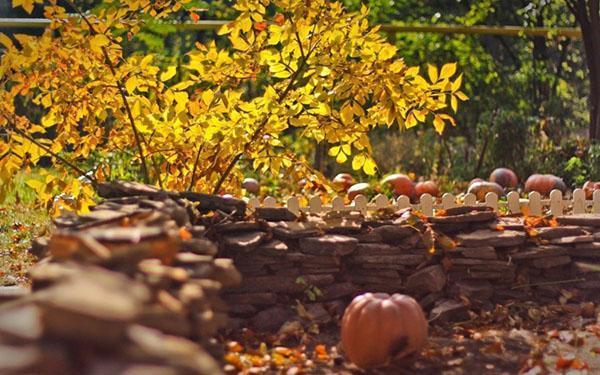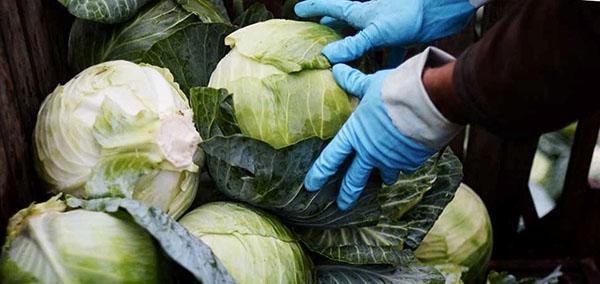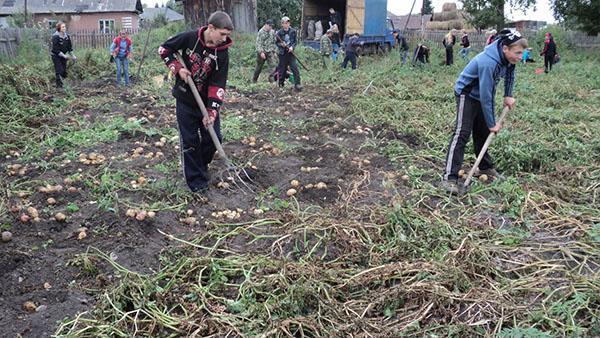Country chores in the beds in October
 Towards the end of autumn, summer residents rush to finish all business in the beds so that the sudden frost does not spoil their plans. In addition to general cleaning in the garden and harvesting fruit trees, you have a lot of work to do in the beds.
Towards the end of autumn, summer residents rush to finish all business in the beds so that the sudden frost does not spoil their plans. In addition to general cleaning in the garden and harvesting fruit trees, you have a lot of work to do in the beds.
Harvesting late cabbage

Cabbage can be stored in its natural form until frost. To do this, tie the heads of cabbage in pairs and hang them on a rope in the cellar or closet.
Picking potatoes and harvesting tomatoes
 Late planting potatoes should be harvested before the first frost, and even better before the rainy season, which usually begins with the arrival of November. A raw crop is likely to rot even if you try to store it in a dry place.
Late planting potatoes should be harvested before the first frost, and even better before the rainy season, which usually begins with the arrival of November. A raw crop is likely to rot even if you try to store it in a dry place.
If you notice that the potatoes have dried tops, then it's time to start harvesting the potato crop.
 As the harvest progresses, the seed potatoes must be sorted. For full maturation, he needs to lie down in the light for 3-4 days. Spread the tubers out on the bag and leave them green.
As the harvest progresses, the seed potatoes must be sorted. For full maturation, he needs to lie down in the light for 3-4 days. Spread the tubers out on the bag and leave them green.
If you have not yet removed the last tomatoes, now you need to do it. With the onset of cold weather, the thin skin of the tomatoes will crack, and the vegetable itself will cease to ripen and quickly deteriorate. The entire harvested crop of tomatoes must be laid out in boxes and, if possible, so that the tomatoes do not come into contact with each other. Do not place boxes for each other. Tomatoes must be stored in a one-story storage facility.
Planting onions and garlic
 After you harvest your potatoes, it's time to think about forcing things. The most favorable period for planting onions is the first weeks of October. Then you can move on to planting garlic.
After you harvest your potatoes, it's time to think about forcing things. The most favorable period for planting onions is the first weeks of October. Then you can move on to planting garlic.
Before planting the onion in the ground, it is recommended to warm it up at a temperature of 30-40 degrees. Trim the top of the bulb's neck and soak it in hot water for a while. Next, place the onion in burlap and store it in a warm room for 3-5 days.
 Wait for more or less persistent cold weather before you plan to plant garlic. We do not advise you to start planting. if the temperature is more than 10 degrees outside, you can plant with garlic in the same period:
Wait for more or less persistent cold weather before you plan to plant garlic. We do not advise you to start planting. if the temperature is more than 10 degrees outside, you can plant with garlic in the same period:
- beets;
- carrot;
- onion sets;
- celery.
When planting the above crops, it is recommended to slightly increase the number of seeds with the expectation that some of them may die from frost.
Seed preparation
For seed propagation, carefully select only good vegetables. After you have collected the testes of various root vegetables, herbs, cabbage, carrots and other plants, they should be placed in a well-ventilated area. To do this, the testis must be laid out on a piece of cardboard. Then proceed as follows:
- Wait for the testes to dry thoroughly.
- Thresh the testes thoroughly and sift them.
- Once again, carefully sort the testes and sift out the slag. Distribute the resulting seeds in small portions into bags.
Ventilation and disinfection of the cellar
 Before you are going to put the result of your October labor in the cellar, you should also prepare it for this, and October is the most favorable month for this. Examine your pantry for fungus. If one was found, then scrape off the growths with a hatchet, and then burn. In order to prevent the fungus from spreading further, the place in which it was found should be carefully treated with a solution of sodium fluoride or an antiseptic.
Before you are going to put the result of your October labor in the cellar, you should also prepare it for this, and October is the most favorable month for this. Examine your pantry for fungus. If one was found, then scrape off the growths with a hatchet, and then burn. In order to prevent the fungus from spreading further, the place in which it was found should be carefully treated with a solution of sodium fluoride or an antiseptic.
If your cellar was built of stone, and not of wood, then it is recommended to burn the place where the fungus accumulates with a blowtorch. This must be done carefully and, if possible, quickly.
Cellars with earthen floors should also be well processed. For this you need a solution copper sulfate... Loosen the soil, process it, and then use the rake again. In October, all walls of the cellar must be treated with lime.